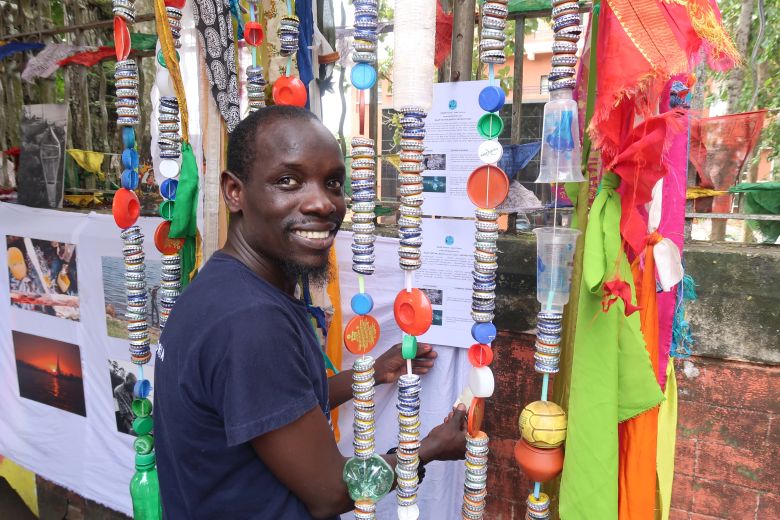About frogs, beavers and eagles (Part 3)
In this “series” of three blog posts, I compare three different film projects. All of them have the goal to initiate positive change but were initiated from different perspectives.
One of them is from the frog’s perspective, he sits in the middle of the challenge and has two options, resignation or action. The next one is a beaver, who looks in from the side, who shows solidarity and acts. And the third is the eagle, which circles high above the entire scene. Eagles, unlike frogs and beavers, have the foresight or “bird’s eye” perspective. They do mainly rely on secondary information, study and compare the compiled data, look back into history and draw conclusions for future action.
Eagles are extremely rare among kantharis. Because usually kantharis want to get immediately involved and do not want to waste time with scientific studies. Therefore, we are happy about any kanthari who can combine a global overview, i.e. a macro perspective, with direct action.
One such eagle, for example, is Dave Ojay from Kenya, a 2018 kanthari graduate.
Dave is the founder of the Naam Festival, and the initiator of the campaign “My lake, my future”, which started in October 2018, here at the local Vellayani Lake.
In his mother tongue Luo, the word ‘Naam’ means “big water”. Dave has set himself the goal of protecting the great waters of the world. How? Through films and festivals.
I must say I was a little skeptical when he announced that he wanted to encourage people to clean up their waters through festivals and film screenings. My objection: “A festival usually comes with some serious sound pollution that scares away the birds, and festivals cause lots of garbage that, with the next heavy rainfall is flushed into the lake.”
But Dave remained stubborn and in fact he managed to recruit over 200, usually rather water shy Trivandrumites into Lake Vellayani for a whole day to cleanse it of rubbish and exotic aquatic plants. There was live music, and those who wanted to relax on the shore were shown documentaries about the urgency of lake rescue operations worldwide. His films and explanations made a lasting impression on everyone, including me.
Link http://www.youtube.com/watch?v=v9CywQb1WW4
Dave himself comes from a village close to Lake Victoria, the largest freshwater reservoir on the African continent. He describes the lake of his homeland as a beating heart and calls the Nile which gets water from Lake Victoria and supplies over 300 million people in 11 countries an artery. But the Lake, according to Dave, is about to have a heart attack. The reasons for this are plenty: overfishing, uncontrolled industrial waste is dumped in the lake, pollution from illegal car washing businesses as well as excessive growth of exotic water plants. He compares the slow death of Lake Victoria with Lake Titicaca in the Andes, an “industrial cloaca”, which is covered by algae carpets and dead fish and/or other aquatic creatures. And he makes another connection, back to India, to Bangalore to Lake Bellandur. Bellandur is the largest lake of the South Indian metropolis. However, it is known for its self-ignited fires and the meter-high poisonous foam capets, which cause dangerous skin and respiratory tract irritations for residents.
“The world has less than 2.5% freshwater reserves, of which 1.7% is stored in glaciers. If we want to survive tomorrow, we have to act today.”
“And what are the concrete options for action?” I asked, still skeptical.
In his wildest dreams, Dave probably would not have believed that we would now face a worldwide lockdown. But even after only a few weeks, the effects on the environment of the Covid crisis are already evident. Suddenly people in Venice discovered the most beautiful fish and octopuses swimming in their lagoons, lakes and rivers seem to clean themselves without people’s help.
Most astonishing of all: the Ganges. The Holy River has been known for decades as muddy and odorous due to toxic waste and corpses, but it does not stop believers from bathing and even drinking a handful of water every visit. And today, due to the temporary closure of the factories along the Ganges, the river is clearer than it has been for a long time. You can even see fish and see the bottom. While industry is currently holding its breath, nature is given a chance to exhale. For the time being, the waters, the forests, the animals, the insects are the winners of this crisis, and yet there is one loser: … The Ganges Dolphin.
The Ganges dolphin has adapted so well to the mud and the resulting poor visibility that its sense of sight has completely regressed. The dolphins have developed an amazing hunting method that is based on sonar. But now the waters are clear, the sighted fish are suddenly in a better position… Listening carefully, you can hear whispers from the schools of sighted Ganges river dwellers: “Look, there comes the blind one! Let’s get out of here!”.

